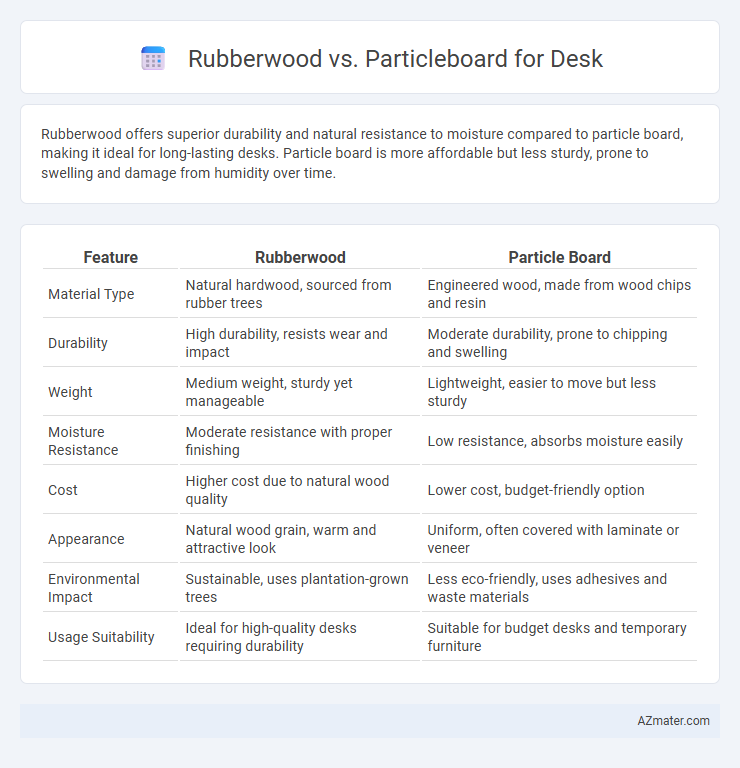Rubberwood offers superior durability and natural resistance to moisture compared to particle board, making it ideal for long-lasting desks. Particle board is more affordable but less sturdy, prone to swelling and damage from humidity over time.
Table of Comparison
| Feature | Rubberwood | Particle Board |
|---|---|---|
| Material Type | Natural hardwood, sourced from rubber trees | Engineered wood, made from wood chips and resin |
| Durability | High durability, resists wear and impact | Moderate durability, prone to chipping and swelling |
| Weight | Medium weight, sturdy yet manageable | Lightweight, easier to move but less sturdy |
| Moisture Resistance | Moderate resistance with proper finishing | Low resistance, absorbs moisture easily |
| Cost | Higher cost due to natural wood quality | Lower cost, budget-friendly option |
| Appearance | Natural wood grain, warm and attractive look | Uniform, often covered with laminate or veneer |
| Environmental Impact | Sustainable, uses plantation-grown trees | Less eco-friendly, uses adhesives and waste materials |
| Usage Suitability | Ideal for high-quality desks requiring durability | Suitable for budget desks and temporary furniture |
Introduction to Rubberwood and Particle Board Desks
Rubberwood desks offer durability and a smooth finish, made from the hardwood of rubber trees, making them environmentally friendly and sturdy for long-term use. Particle board desks are crafted from wood chips and resin, providing a cost-effective and lightweight option but generally less durable than solid wood. Choosing between them depends on budget, desired strength, and aesthetic preferences for home or office furniture.
Understanding Rubberwood: Features and Benefits
Rubberwood, derived from the Para rubber tree, is a durable and eco-friendly hardwood known for its high density and resistance to warping, making it ideal for desk construction. Its natural light color and fine grain provide an attractive finish that can be easily stained or laminated, enhancing aesthetic appeal and customization. Rubberwood's sustainability stems from using mature trees at the end of their latex-producing cycle, reducing deforestation and promoting responsible forestry practices.
What Is Particle Board? Pros and Cons
Particle board is an engineered wood product made from wood chips, sawdust, and resin compressed into sheets, commonly used in furniture manufacturing due to its affordability. Its pros include cost-effectiveness, smooth surface for veneers, and resistance to warping, while the cons involve lower durability, susceptibility to moisture damage, and weak screw-holding capacity compared to solid wood. For desks, particle board offers budget-friendly options but may lack the longevity and robustness found in materials like rubberwood.
Durability Comparison: Rubberwood vs Particle Board
Rubberwood is significantly more durable than particle board due to its dense hardwood composition, which resists wear, scratches, and moisture better. Particle board, made from compressed wood chips and resin, is prone to swelling, warping, and damage when exposed to moisture or heavy use. For a desk, rubberwood offers superior longevity and structural integrity, making it ideal for long-term durability.
Aesthetic Differences: Appearance and Texture
Rubberwood desks exhibit a natural, warm grain pattern with a smooth, fine texture that enhances the wood's aesthetic appeal, often finished with clear varnish to highlight its organic beauty. Particle board desks display a uniform, flat surface with a synthetic, sometimes mottled or laminated finish that lacks the distinctive grain and tactile richness found in solid wood. The visual sophistication and tactile experience of rubberwood contribute to a higher-end, classic look, while particle board offers a more utilitarian and mass-produced appearance.
Environmental Impact: Sustainability Factors
Rubberwood, sourced from aged latex trees no longer productive, is a renewable and biodegradable material that supports sustainable forestry practices, reducing deforestation. Particle board, often made from wood chips, sawdust, and synthetic resins, utilizes wood waste but may emit formaldehyde-based VOCs, impacting indoor air quality and environmental health. Choosing rubberwood desks promotes eco-friendly manufacturing with lower chemical emissions, while particle board offers resource efficiency but requires careful assessment of resin types and recycling potential.
Cost Analysis: Price Comparison for Desks
Rubberwood desks typically cost more than particle board desks due to the durability and sustainability of natural hardwood materials, with prices ranging from $150 to $400 depending on craftsmanship. Particle board desks offer a budget-friendly alternative, often priced between $50 and $150, but may require more frequent replacement due to lower strength and susceptibility to moisture damage. Evaluating long-term investment, rubberwood provides better value through extended lifespan and maintenance, while particle board suits short-term, cost-sensitive furniture needs.
Weight and Ease of Handling
Rubberwood is significantly heavier than particle board, which can affect the ease of handling during desk assembly and relocation. Particle board's lighter weight makes it more manageable for frequent moves or adjustments, but it lacks the robust durability provided by rubberwood. Choosing rubberwood offers a sturdier, long-lasting desk while particle board prioritizes convenience and portability.
Maintenance and Longevity
Rubberwood desks offer superior durability and require minimal maintenance, resisting warping and damage from moisture better than particle board. Particle board desks often need careful handling to avoid swelling or chipping and typically require protective coatings to extend their lifespan. Choosing rubberwood ensures a longer-lasting, low-maintenance workspace compared to the more fragile and maintenance-intensive particle board.
Which Material Is Best for Your Desk?
Rubberwood offers superior durability and a natural, attractive finish, making it ideal for desks that require long-lasting strength and aesthetic appeal. Particle board is more affordable and lightweight but lacks the structural integrity and resistance to moisture, often leading to warping or damage under heavy use. For a desk that balances cost, durability, and appearance, rubberwood is generally the best choice.

Infographic: Rubberwood vs Particle Board for Desk
 azmater.com
azmater.com